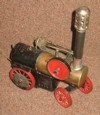
Weeden History | |||
| The Weeden Manufacturing Company was started by William N. Weeden in the 1880s in New Bedford, Massachusetts. The company first produced oil lamp burners and tin plate household items. Through his dealings he came to meet the owner of the "Youth's Companion" magazine where they struck up a deal to produce toy steam engines to give away as premiums for his magazine. The engine that Weeden produced was the Weeden No.1 which was priced at $1.00 and held a patent date of May 19, 1885, and manufactured up to 1905. Other products he made was comb cases, match safes and the Weeden Magic Lantern. William N. Weeden died in 1891 and taking control of the company was a long time employee and salesman, William Ritchie. In the 1890's the Weeden Company expanded their line of steam engines featuring cast iron bases, large brass boiler, nickel plating and more realistic looking steam engines. At this time was the 'glory' days as steam was the power source in factories and heavy equipment. This gave a direct relationship kids could see how power was produced. In the early years the engine was run exclusively on wood alcohol with exception of the N0.20 which could also be run on kerosene or heating oil as well as alcohol. In 1926-27 electric heat was introduced on some engines and in the same period, various models were fitted with electric heat and given new model numbers. By 1940 there were at least 110 different steam engines that Weeden had produced. In 1942 Weeden was sold to National Playthings. The steam craze was over and manufactures across the country had abandon steam and now used electric motors and diesel engines. The new owners trimmed the product line down to six engines and only two heated with alcohol. 1952 was the last of the Weeden company. Behind the 110+ different models, plus other Weeden toys, Weeden left a memorable legacy. | |||
Weeden Models | |||
 123 |  14 |  155 |  17 |
 20 |  341 |  400 |  420 |
 43 |  49 |  500 |  647 |
 648 |  672 |  7 |  702 |
 8 |  900 |  903 |  Dart Locomotive |
 Dart plus tender |  Mighty-Mite |  643 | |
| Home... | Copyright 2021 www.toysteambible.org.uk |